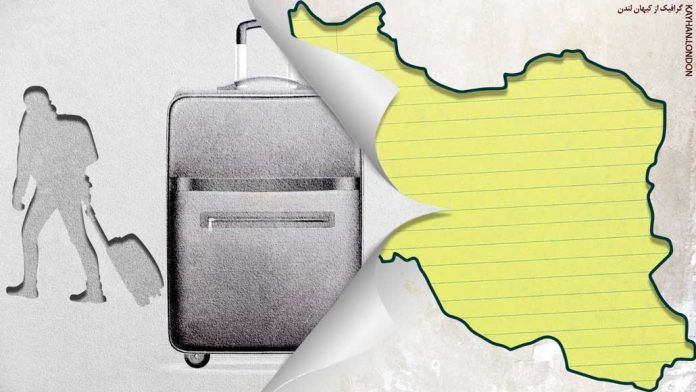By Kayhan Life Staff
A record number of people have left Iran in recent years, including academics, engineers, doctors, nurses, athletes, skilled laborers and construction workers. Until a few years ago, the departing were students, most of whom would return home after completing their studies, or civil rights activists and dissidents who left to escape persecution at the hands of the Iranian judiciary and security forces.
Nowadays, many ordinary Iranians are wondering whether they should stay in or leave the country. A few years ago, Europe, the U.S., and Australia were the top destinations for most Iranians who wished to emigrate to other countries. Recent data has shown that Iranian families would be prepared to move to any country as long as they can leave Iran. While politics was the key factor in pushing people to leave Iran in the past few decades, economics is the driver behind the desire by most ordinary Iranians to emigrate.
A report by the Iran Immigration Observatory in 2020 showed that the number of people leaving Iran had quadrupled in the previous three years. The Iran Immigration Observatory is a research center established in 2018 by Tehran’s Sharif University of Technology and the President’s office.
Data also showed that the emigration rate had tripled between 2017 and 2020. Political and economic conditions sparked nationwide protests in July 2017, December 2017, August 2018, and November 2019, which led to many deaths, scores of injuries, and arrests at the hands of security forces and riot police.
[aesop_image img=”https://kayhanlife.com/wp-content/uploads/2020/11/2020-10-26T090847Z_337700186_RC29QJ95AJHB_RTRMADP_3_HEALTH-CORONAVIRUS-IRAN-scaled.jpg” panorama=”off” credit=”REUTERS./ ” align=”center” lightbox=”on” captionsrc=”custom” caption=”FILE PHOTO: Iranian people wear masks, amid a rise in the coronavirus disease (COVID-19) infections, West Tehran, Iran October 23, 2020. ” captionposition=”left” revealfx=”off” overlay_revealfx=”off”]
Iran experienced what was arguably the worst economic crisis in its history between 2017 and 2020. According to a report by the Statistical Center of Iran (SCI), the inflation rate was 8.2 percent in 2019 but rose to 50 percent by 2020. The rial experienced a sharp drop in value in that time. As a result, the value of the capital investment based on the rial, the average monthly income, and the purchasing power of people dropped sharply, and millions of middle-class households were pushed into poverty.
Data shows a direct correlation between the increasing number of Iranians leaving the country and the worsening economic and political conditions under the Islamic Republic’s rule. Institutionalized corruption, nepotism, growing political insecurity, and economic risks have increased the outflow of capital from the country. The Islamic Republic has altogether failed to attract direct and indirect foreign investment.
According to official government reports, some $171 billion in the capital has left Iran in the past 16 years. Investors took a significant amount of this money and wealth, as well as economic creativity and entrepreneurship, out of the country. However, embezzlement and misappropriation of public funds accounted for a large part of this capital outflow.
Many less affluent households have bought homes in Asia to protect their capital and secure a residency in a foreign country. Malaysia, Turkey, and Georgia have become the primary destinations for Iranians who wish to start a new life in other countries. A report by the Iran Immigration Observatory said Turkey was the top destination for Iranians who wish to settle in another country.
The number of Iranians who emigrated to Turkey quadrupled between 2017 and 2019. According to the Iranian Foreign Ministry, 126,000 Iranian nationals currently live in Turkey. The Turkish Statistical Institute (TUIK) report said Iranians bought some 1,323 houses in September alone, topping the list of foreign house buyers in Turkey.
A report in the Tehran-based Farhikhtegan daily newspaper said capital outflow from the Iranian economy continued when the global economy showed signs of stability, like in 2016, and during the height of international and economic pessimism in 2018.
Iran has steadily been losing skilled labor and professionals in the past decades. While many well-educated and highly skilled Iranians find temporary work abroad, others move to other countries permanently. The troubled economy and salaries and wages that are unadjusted to the cost-of-living index are the principal cause of the high emigration rate.
Some 1,000 doctors have reportedly applied for a license to practice medicine in other countries this summer alone. Meanwhile, Iran is still grappling with the Coronavirus pandemic. Senior officials at the Ministry of Health and Medical Education have reported a shortage of at least 50,000 doctors and nurses in Iran, a severe challenge to the country’s healthcare system.
According to Mohammad Hossein Mandegar, a cardiothoracic surgeon, many people will be forced to get their heart operations abroad in the coming years, given the high emigration rate of medical professionals and the significant drop in the number of junior doctors training to become cardiovascular surgeons. Alternatively, Iran will have to bring foreign surgeons to the country to compensate for the shortage of specialists.
According to Mohammad Sharifi Moghaddam, the Secretary-General of the Iranian Nurse’s Home (a nursing union), the number of nurses applying for an immigrant visa has increased by nearly 500 percent in the past two years. Mr. Moghaddam added that while between 200 and 300 nurses received their certificates each year, some 1,500 nurses leave the country every year. Many in the skilled labor force, including engineers and technicians, have found jobs in several neighboring Arab countries and the Persian Gulf States.
Mohammad Vahidi, the deputy chairperson of the Education and Research Committee of the Majlis (Iranian Parliament), recently said Iran ranked first among 98 countries with the highest rate of brain-drain and loss of skilled professionals. According to official data, 25 percent of Iran’s National Elites Foundation (INEF) members and 15 percent of the “ranks below one 1,000” in the national university entrance exams live in other countries.
Also, 37 percent of top award winners in the student science Olympiads emigrated to other countries between 2001 and 2012. Some 186 companies in Iran are certified to secure admissions to foreign universities for Iranian students. While some students get university admissions using unlicensed companies, others apply directly to a university admission office or graduate school department. Still, many others apply for a visa through foreign embassies or with the help of friends and relatives living abroad.
Dire economic conditions and political pressures have forced many athletes who have won medals at international competitions and Olympic games to leave Iran and settle in other countries. Insufficient income is the principal reason. For instance, Iranian super-middleweight professional boxer Masoud Abdollah had to make a living as a street vendor.
Iranians who excel in disciplines including judo, taekwondo, wrestling, and even chess have left Iran in recent years and sought asylum in other countries after they had to fake an injury or were ordered by the Islamic Republic officials not to face their Israeli opponents in international competitions. In recent years, various international sporting bodies have penalized Iranian athletes for refusing to compete against an Israeli opponent. In the past decade alone, an unprecedented 60 Iranian athletes have sought political asylum in foreign countries.
After Syria, Iran had the highest number of athletes in the IOC Refugee Olympic Team, Tokyo 2020. Not all Iranian athletes who want to pursue their professional careers abroad can leave, and many have to stay in Iran for various reasons. According to Rasoul Khadem, the former director and head coach of the Iranian national wrestling team, many athletes and their families live in poverty.
For years, Iranian civil rights activists, dissidents, artists, writers, journalists, and intellectuals have sought asylum in the West and other countries. The data on immigration does not include skilled laborers and professionals who are on temporary work schemes abroad and those who have left Iran and entered other countries illegally.
Reza Mousavi, an immigration expert, believes that the actual number of Iranians who have emigrated to other countries is 30 percent higher than the official figure.





